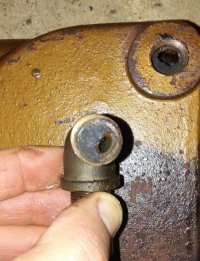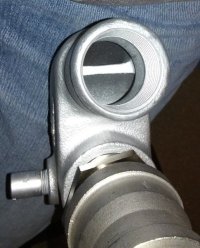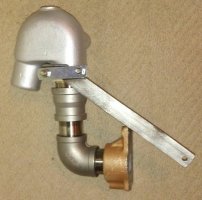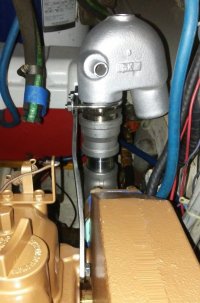Returned to sailing in 2016 after a 20 year absence.
As I mentioned in the previous post, I was unable to remove the bottom flange nut that held the exhaust flange on to the exhaust manifold. It wasn’t simply a case of the nut being frozen on the stud; there just wasn’t enough physical clearance to get a wrench-head between the bottom of the exhaust riser and the nut itself (i.e. the flange must have been bolted to the manifold before the riser was screwed onto the flange). (see photo #1)
The first question for me was, did I want to reinstall the same parts in this same fashion? Once I saw the condition of the Riser/Elbow (R/E), it was clear I was not going to use recycle the part. The injection elbow portion of the riser was about 90% blocked from particulate gunk (photo#2). With no reliable way to clean out or inspect the internal passages of the R/E, this part was a throw-away. Question number two: Replace with a similar, Westerbeke one-piece R/E (the original Universal part is no longer available), or switch to a Yanmar style elbow? I chose the Yanmar route for these reasons:
Some additional notes on the construction of my pipe-riser with Yanmar elbow (photo #3):
The first piece of the riser is the 1.25 in nipple that threads into the exhaust flange. I chose to use a Schedule 80 (thick walled) nipple and not Schedule 40 (thin walled). The nipple winds up supporting all of the weight of the R/E and most of the associated hoses. I don’t think the thin-walled pipe would be up to that task for very long. Since the second piece of the riser assembly is a 90 degree bend, one option would be to replace the nipple and 90-bend with a one-piece “street elbow.” I chose to go with the two separate pieces—the additional threaded joint allows one more degree of freedom when trying to align the riser pipe vertically while screwing into the flange.
The Yanmar elbow comes with it’s own reverse-threaded coupler nipple used to attach it to the pipe fittings below. It has reverse threads on the elbow side and normal threading on the pipe side (this reverse threading means that as you rotate the coupling, it screws/unscrews itself simultaneously from both the elbow above and the pipe below). This Yanmar coupler is 1.5” in diameter, so you will need a step-down coupler to mate with the rest of the 1.25” riser fittings. The Yanmar coupler is also threaded in BSPT (Bristish Standard) rather than NPT pipe thread. At the 1.25-1.5” range, BSPT carries about an extra half-thread per inch vs NPT. This would be a no-go for high pressure liquid or steam applications. In our low pressure exhaust system, however, most installers simply disregard the mis-match and screw the two together (which seems to work satisfactorily). I took just one additional step: I searched McMaster Carr for a 1.5” to 1.25” reducer coupling with BSPT threads. They carry one in 304 stainless (though not 316 stainless). By using this BSPT coupler, I figured I at least get a well-matched connection between the Yanmar coupler and the step-down coupler (which should facilitate easy of removal and re-installation when I want to clean the Yanmar elbow). The mis-matched threads then, are between the 1.25” side of the BSPT coupler and the 1.25” NPT pipe it attaches to. As this joint should never require removal, I sealed the top of the joint with high-temp silicone as a leak precaution after I screwed the two parts together.
Finally, while 316 stainless steel is the best pipe-material choice in terms of corrosion resistance, stainless-on-stainless connections are also the most prone to galling (cold-welding), which can make them difficult-to-impossible to remove. The cure for anti-galling is a high quality anti-seize compound (I used Nickel-based anti-seize) between the joined threads. The anti-seize, however is essentially a lubricant, which means your pipe fittings may become loose due to the stresses and vibrations of their application. I read of some boat owners who held their pipe connections in place with wood blocks until corrosion helped the joints solidify. With anti-seize limiting corrosion, I suspect this might never happen in my case. My fix for this was to build a support bracket to help hold the R/E in place (photo #5). My hope is that might reduce overall engine vibrations, as well, since the whole R/E, which weighs about 9 lbs, is hanging suspended off the back of the engine, connected otherwise by only a 1.25 in pipe nipple. I anchored the support bracket to the engine “lifting hook” bolt on the aft port cylinder head (the bad news is that you have to have the exhaust manifold removed in order to have access to the lifting-hook bolt—I was already in there working, so it was a simple solution for me).
A final note on the both the Yanmar and Westerbeke/Universal type riser elbows: From a purists standpoint, both can be (and are, by some) considered a “faulty” design because the water inlets are on the “uphill” side (i.e, before the elbow turns downward) of the elbow. The thought is, that if the internal water-jacket (photo #4) wall of the elbow corrodes, the design can allow water to flow into the exhaust valves rather than out the exhaust end of the riser. The advantage of course, of injecting water on the uphill side, is that it cools the top of the elbow (the hottest part) and it stays in contact with the hot metal much longer (thus providing better cooing) than if it were injected on the downhill side, just before the exhaust gasses exit the elbow. I chose to ignore the purist view with the practical view that:
1. The Yanmar design is and has been probably the most popular design in use for decades, without a reputation for such failures, and
2. That the more common failure path isn’t corrosion and rust-through of the water jacket, but a buildup of solid particulate and clogging of the water jacket. Such was my experience with the Universal R/E I pulled off my engine.
The first question for me was, did I want to reinstall the same parts in this same fashion? Once I saw the condition of the Riser/Elbow (R/E), it was clear I was not going to use recycle the part. The injection elbow portion of the riser was about 90% blocked from particulate gunk (photo#2). With no reliable way to clean out or inspect the internal passages of the R/E, this part was a throw-away. Question number two: Replace with a similar, Westerbeke one-piece R/E (the original Universal part is no longer available), or switch to a Yanmar style elbow? I chose the Yanmar route for these reasons:
1. The price of Universal/Westerbeke parts seems to go up dramatically when they are in short supply ($700 engine mounts come to mind). If I ever needed to replace the Westebeke unit in the future, I didn’t want to be hi-jacked if it’s in short supply. The Yanmar elbow seems to be the go-to part in this arena, so I assumed it might still be easier to come by a few years down the road.
2. Additionally, with the Yanmar part, you are just buying the elbow; you build the riser portion yourself with standard, off-the-shelf, inexpensive pipe fittings. As most people recommend, I went with 316 stainless for most of the pipe connections in the riser.
3. It seems the Yanmar elbow should be easier to remove/re-install for cleaning. The Westerbeke R/E is always going to require removal of the exhaust flange and draining/re-filling of the manifold because there is not enough room in the E32 engine bay to rotate the R/E off via the 1.25” nipple fitting. The Yanmar elbow, however, can be twisted off of the top of the pipe riser even within the confines of the engine compartment.
Some additional notes on the construction of my pipe-riser with Yanmar elbow (photo #3):
The first piece of the riser is the 1.25 in nipple that threads into the exhaust flange. I chose to use a Schedule 80 (thick walled) nipple and not Schedule 40 (thin walled). The nipple winds up supporting all of the weight of the R/E and most of the associated hoses. I don’t think the thin-walled pipe would be up to that task for very long. Since the second piece of the riser assembly is a 90 degree bend, one option would be to replace the nipple and 90-bend with a one-piece “street elbow.” I chose to go with the two separate pieces—the additional threaded joint allows one more degree of freedom when trying to align the riser pipe vertically while screwing into the flange.
The Yanmar elbow comes with it’s own reverse-threaded coupler nipple used to attach it to the pipe fittings below. It has reverse threads on the elbow side and normal threading on the pipe side (this reverse threading means that as you rotate the coupling, it screws/unscrews itself simultaneously from both the elbow above and the pipe below). This Yanmar coupler is 1.5” in diameter, so you will need a step-down coupler to mate with the rest of the 1.25” riser fittings. The Yanmar coupler is also threaded in BSPT (Bristish Standard) rather than NPT pipe thread. At the 1.25-1.5” range, BSPT carries about an extra half-thread per inch vs NPT. This would be a no-go for high pressure liquid or steam applications. In our low pressure exhaust system, however, most installers simply disregard the mis-match and screw the two together (which seems to work satisfactorily). I took just one additional step: I searched McMaster Carr for a 1.5” to 1.25” reducer coupling with BSPT threads. They carry one in 304 stainless (though not 316 stainless). By using this BSPT coupler, I figured I at least get a well-matched connection between the Yanmar coupler and the step-down coupler (which should facilitate easy of removal and re-installation when I want to clean the Yanmar elbow). The mis-matched threads then, are between the 1.25” side of the BSPT coupler and the 1.25” NPT pipe it attaches to. As this joint should never require removal, I sealed the top of the joint with high-temp silicone as a leak precaution after I screwed the two parts together.
Finally, while 316 stainless steel is the best pipe-material choice in terms of corrosion resistance, stainless-on-stainless connections are also the most prone to galling (cold-welding), which can make them difficult-to-impossible to remove. The cure for anti-galling is a high quality anti-seize compound (I used Nickel-based anti-seize) between the joined threads. The anti-seize, however is essentially a lubricant, which means your pipe fittings may become loose due to the stresses and vibrations of their application. I read of some boat owners who held their pipe connections in place with wood blocks until corrosion helped the joints solidify. With anti-seize limiting corrosion, I suspect this might never happen in my case. My fix for this was to build a support bracket to help hold the R/E in place (photo #5). My hope is that might reduce overall engine vibrations, as well, since the whole R/E, which weighs about 9 lbs, is hanging suspended off the back of the engine, connected otherwise by only a 1.25 in pipe nipple. I anchored the support bracket to the engine “lifting hook” bolt on the aft port cylinder head (the bad news is that you have to have the exhaust manifold removed in order to have access to the lifting-hook bolt—I was already in there working, so it was a simple solution for me).
A final note on the both the Yanmar and Westerbeke/Universal type riser elbows: From a purists standpoint, both can be (and are, by some) considered a “faulty” design because the water inlets are on the “uphill” side (i.e, before the elbow turns downward) of the elbow. The thought is, that if the internal water-jacket (photo #4) wall of the elbow corrodes, the design can allow water to flow into the exhaust valves rather than out the exhaust end of the riser. The advantage of course, of injecting water on the uphill side, is that it cools the top of the elbow (the hottest part) and it stays in contact with the hot metal much longer (thus providing better cooing) than if it were injected on the downhill side, just before the exhaust gasses exit the elbow. I chose to ignore the purist view with the practical view that:
1. The Yanmar design is and has been probably the most popular design in use for decades, without a reputation for such failures, and
2. That the more common failure path isn’t corrosion and rust-through of the water jacket, but a buildup of solid particulate and clogging of the water jacket. Such was my experience with the Universal R/E I pulled off my engine.





